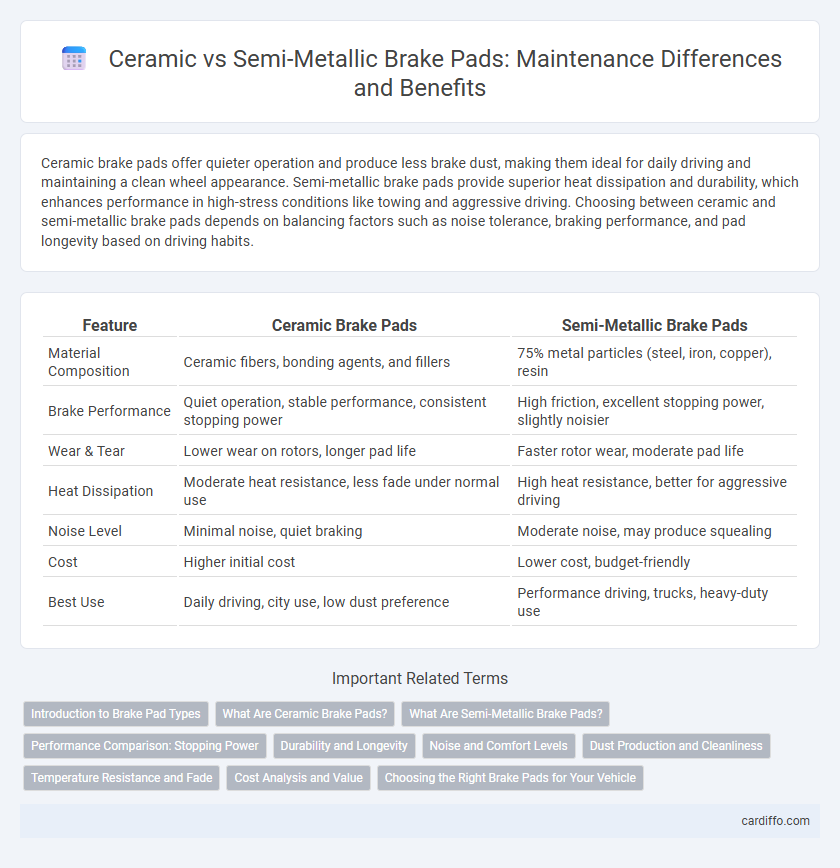Ceramic brake pads offer quieter operation and produce less brake dust, making them ideal for daily driving and maintaining a clean wheel appearance. Semi-metallic brake pads provide superior heat dissipation and durability, which enhances performance in high-stress conditions like towing and aggressive driving. Choosing between ceramic and semi-metallic brake pads depends on balancing factors such as noise tolerance, braking performance, and pad longevity based on driving habits.
Table of Comparison
| Feature | Ceramic Brake Pads | Semi-Metallic Brake Pads |
|---|---|---|
| Material Composition | Ceramic fibers, bonding agents, and fillers | 75% metal particles (steel, iron, copper), resin |
| Brake Performance | Quiet operation, stable performance, consistent stopping power | High friction, excellent stopping power, slightly noisier |
| Wear & Tear | Lower wear on rotors, longer pad life | Faster rotor wear, moderate pad life |
| Heat Dissipation | Moderate heat resistance, less fade under normal use | High heat resistance, better for aggressive driving |
| Noise Level | Minimal noise, quiet braking | Moderate noise, may produce squealing |
| Cost | Higher initial cost | Lower cost, budget-friendly |
| Best Use | Daily driving, city use, low dust preference | Performance driving, trucks, heavy-duty use |
Introduction to Brake Pad Types
Ceramic brake pads consist of dense ceramic compounds combined with copper fibers, offering quieter operation and less brake dust compared to semi-metallic pads. Semi-metallic brake pads contain a blend of metal fibers, such as steel or copper, providing superior heat dissipation and durability under heavy braking conditions. Understanding the composition and performance characteristics of ceramic versus semi-metallic brake pads is essential for optimal vehicle maintenance and safety.
What Are Ceramic Brake Pads?
Ceramic brake pads are composed of dense ceramic fibers combined with nonferrous filler materials, providing excellent heat resistance and quiet operation. These pads generate less brake dust, which reduces wheel contamination and maintenance frequency. Their durability and stable friction performance make them ideal for everyday driving and high-temperature conditions.
What Are Semi-Metallic Brake Pads?
Semi-metallic brake pads consist of a mixture of metal fibers and organic materials, providing enhanced durability and heat dissipation. These pads offer superior braking performance under high temperatures, making them ideal for heavy-duty and high-performance vehicles. Their composition results in increased noise and wear on rotors compared to ceramic brake pads, but they excel in toughness and cost-effectiveness.
Performance Comparison: Stopping Power
Ceramic brake pads provide strong stopping power with minimal brake fade, maintaining consistent performance under various driving conditions. Semi-metallic brake pads typically offer superior initial bite and better heat dissipation, making them highly effective for high-performance or heavy-duty applications. The choice between ceramic and semi-metallic pads depends on factors such as driving style, vehicle weight, and temperature tolerance requirements.
Durability and Longevity
Ceramic brake pads offer superior durability and longer lifespan compared to semi-metallic brake pads due to their composition of dense ceramic fibers and bonding agents, which resist wear and heat better. Semi-metallic brake pads, containing steel fibers and other metals, tend to wear faster under high heat and aggressive driving conditions, reducing their overall longevity. For vehicles requiring consistent performance with minimal maintenance, ceramic brake pads provide enhanced durability and extended service intervals.
Noise and Comfort Levels
Ceramic brake pads generate less noise during braking due to their dense composition, resulting in quieter stops and improved comfort for drivers. Semi-metallic brake pads often produce more noise because of their metal content, which can cause vibrations and a louder braking experience. Comfort levels favor ceramic pads as they minimize brake dust and reduce harshness, contributing to smoother and quieter rides.
Dust Production and Cleanliness
Ceramic brake pads produce significantly less brake dust compared to semi-metallic pads, contributing to cleaner wheels and reducing the frequency of maintenance. The fine dust generated by ceramic pads is lighter and less abrasive, minimizing residue buildup on brake components and wheel surfaces. In contrast, semi-metallic brake pads generate coarser, darker dust that tends to accumulate rapidly, requiring more frequent cleaning to maintain wheel aesthetics and optimal brake system performance.
Temperature Resistance and Fade
Ceramic brake pads exhibit superior temperature resistance, maintaining consistent performance even under extreme heat, which significantly reduces the risk of brake fade during prolonged or intense braking. Semi-metallic brake pads, while durable and effective at heat dissipation, tend to experience more fade as their metallic content heats up, compromising braking efficiency in high-temperature conditions. Choosing ceramic pads enhances brake system reliability by minimizing fade and ensuring stable stopping power across a wider temperature range.
Cost Analysis and Value
Ceramic brake pads typically cost 20-30% more than semi-metallic brake pads but offer longer lifespan and quieter operation, enhancing overall value despite higher upfront investment. Semi-metallic pads provide superior heat dissipation at a lower price, making them a cost-effective choice for budget-conscious drivers requiring durability under extreme conditions. Evaluating total cost of ownership, including replacement frequency and performance benefits, positions ceramic pads as a premium option while semi-metallic pads remain a practical, economical alternative.
Choosing the Right Brake Pads for Your Vehicle
Ceramic brake pads offer quieter operation, reduced brake dust, and longer lifespan, making them ideal for everyday driving and light-duty vehicles. Semi-metallic brake pads provide superior heat dissipation and enhanced stopping power, preferred for heavy-duty applications or performance vehicles. Selecting the right brake pads depends on your driving habits, vehicle type, and maintenance priorities to ensure optimal safety and durability.
Ceramic Brake Pads vs Semi-Metallic Brake Pads Infographic

 cardiffo.com
cardiffo.com